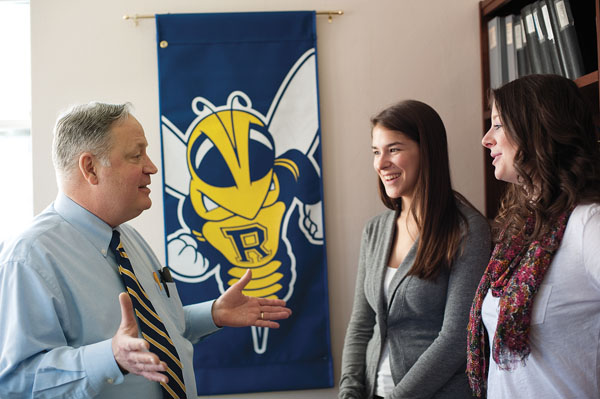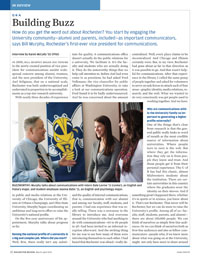In Review
 BUZZWORTHY: Murphy talks about communications with intern Dale Levine ’11 (center), an English and history major, and student employee Joanna Balin ’11, an English and psychology major. (Photo: Adam Fenster)
BUZZWORTHY: Murphy talks about communications with intern Dale Levine ’11 (center), an English and history major, and student employee Joanna Balin ’11, an English and psychology major. (Photo: Adam Fenster)In 2006, Bill Murphy began his tenure in the newly created position of vice president for communications amidst widespread concern among alumni, trustees, and the new president of the University, Joel Seligman, that on a national scale, Rochester was both underrecognized and underrated in proportion to its accomplishments as a top-tier research university.
With nearly three decades of experience in public and media relations at the University of Chicago, the University of Illinois at Urbana-Champaign, and Ohio State University, Murphy began coordinating an ambitious and long-term effort to raise the University’s national profile.
On the five-year anniversary of his appointment, Murphy talks about progress so far.
Raising the national profile of a university is a big and complex job. Where did you start?
Well, first, there really isn’t any substitute for quality. A communications office doesn’t actually do the public relations for a university. We facilitate it. It’s the faculty and students who are actually doing it. They do the noteworthy things that we help call attention to. Before Joel had even come in as president, he had asked Fred Volkmann, the vice chancellor for public affairs at Washington University, to take a look at our communications operation. Fred found it to be badly underresourced. And he was concerned about the amount and the quality of internal communications; that is, communication with our alumni and among our faculty, staff, students, and parents. I had one experience that was really telling. There was a ceremony in the library to introduce me. And everyone around the University who had anything to do with communications—60 to 80 people in all—had been invited to an informal reception afterward. And the striking thing for me was to see how many of them were introducing themselves to each other. I had heard that Rochester was siloed—really decentralized. Well, every place claims to be decentralized. And Chicago and Illinois certainly were. But, in my view, Rochester had gone about as far in that direction as it was possible to go. And that wasn’t helpful for communications. After that experience in the library, I called the same group of people together and asked for volunteers to serve on task forces to attack each of four areas—graphic identity, media relations, research, and the web. What we wanted to do very consciously was get people used to working together. And we have.
Why are communications within the University family so important to generating a higher profile externally?
One of the things that’s clear from research is that the general public really looks to word of mouth as the most credible source of information about universities. Where people turn to next is the web. But where they get the information they rely on is from people they know and trust. And those people get it from their personal experience. The U of R has had this classic, almost Midwestern modesty about the institution. There are certain universities in this country where the graduates wear the identity on their sleeves. And if something great’s happened there, whether it’s in sports or in science, you know about it. That’s not Rochester. That never will be Rochester, but we can do more to raise the University’s profile. Among all of us—faculty, staff, students, parents, and alumni—there are about 150,000 people. We can think of ourselves as simply first-line audiences. Or we can think of ourselves both as first-line audiences and also as fellow communicators—people who, if we knew more about what was going on at the University, might not only have more to share around the water cooler, at the tennis club, at church, or over the back fence, but also be more motivated to share it. It takes a combination of pride and information to make that dynamic work. I don’t think we in communications have to cheerlead to create the pride. I think all we have to do is communicate what really goes on here.
What results came from the work of the task forces?
First, we created a strong and unified graphic identity—a new logo for the entire University—using our in-house design team with substantial input and feedback from students, faculty, and alumni. [See “The New Face of Rochester,” Rochester Review, September-October 2007.] We also created vehicles that inform people about what goes on. We enhanced Currents and @Rochester, the faculty and staff print and online newsletters, and we created newsletters for undergraduates, for graduate students, for parents, and for alumni—Weekly Buzz, Grads@Rochester, Parents Buzz, and Rochester Buzz—as a way to inform the community, first of all, about news we can use: just basic information that helps us in our roles within the University family. Those vehicles also give all of us information about wonderful things that are going on here. And I think that naturally generates some pride in the place. We also have on our website, with a direct link from the homepage, a page that we call the Newsroom, which in turn has links to our Facebook, YouTube, and Twitter feeds. This is something that most major universities have developed in the last five years. It’s basically a daily multimedia newspaper about the university.
Tell us about your efforts to strengthen media relations for Arts, Sciences, and Engineering.
We brought in Larry Arbeiter from the University of Chicago as associate vice president for communications. He had run a very successful media relations operation at Chicago for about 20 years. He had shown a real capability at building staffs. And he’s come in here and built a strong group of press relations officers, with beats that they follow, to keep up with faculty in the humanities, the social sciences, the natural sciences, engineering, and student life and teaching. Their jobs are to get to know what’s happening on campus, and what the newsworthy things are. They also get to know what journalists in their areas are interested in, and they match up those interests and pitch stories.
How is the University’s media relations team dealing with shrinking newsrooms and, in particular, shrinking coverage of discoveries in science?
One of our responses to the shrinking space and air time for coverage of research was to team up with Duke and Stanford universities as leaders in creating Futurity.org, an online news service that features articles about university-based research. Membership in Futurity is confined to members of the Association of American Universities and to the Russell Group in Britain—the best universities in the United States, Canada, and the UK. Futurity has developed partnerships with Alltop and other news providers that have multiplied its reach. It’s a real point of pride for us that Rochester is the linchpin for this effort. Each of the three universities plays an important role, but Rochester has played the lead role in editing and designing the site and in coming up with innovative ways to develop it.
Many colleges and universities are trying to define themselves through branding. How do you go about communicating the personality of the U of R?
The actual branding, as I think of it, is really articulating what’s already there; it’s not imposing something on a university. That’s why we went with traditional colors and symbols in our graphic identity, why we embrace the dandelion and Rocky—a weed and an insect—because they’re our heritage. And that’s why we have the motto, Meliora, “Ever Better.” We try to reflect the quality of the research that happens here, the wonderful academic experience the students have, the imagination that they bring to work and play. Branding Rochester means holding up a mirror to the terrific university that it is.
Tell us about Rochester’s homepage.
We’re very distinctive in higher education for the sense of fun you can feel on our homepage. I’ve tried to give talented people, like our web editor and designers, the freedom to be as creative as they are. I’ve learned that we can do wonderful things if I just say “yes,” and get out of the way. So they came to me with the idea for “Photo Fridays,” in which all members of the University community—students, faculty, staff, alumni, and parents—are invited to submit photos for the homepage each Friday. And now, every Friday through Monday morning, our homepage looks different with photos, usually of the university, often of Rochester, that frankly are not ones that we necessarily would have thought of. And it’s exciting to see the same place from a very fresh perspective. They capture early morning light, late night views, they see things from corner windows, and capture student activities that just bring the place to life. The same creative group came to me with an idea to celebrate Mother’s Day by inviting students to greet their mothers on the web page. And lo and behold, we soon had a tradition of celebrating nearly every holiday. So you can visit the University’s homepage on any given holiday and there will be something special, and almost nobody else will be doing it. We have a friendly rivalry with Johns Hopkins, and they do things occasionally, and there are a few others, but very few, and we also have colleagues who’ve expressed real envy that they just don’t have the freedom that Joel has given us to express our creativity.
How can alumni and parents help to “build the buzz”?
Alumni and parents are a vital part of the communications effort of this university. Our goal in communications is to make sure that alumni, parents, and all members of the University community are informed about why Rochester is an extraordinary university so that we can all talk knowledgeably about the place with our friends, coworkers, and colleagues. In this issue of Rochester Review, we have provided one extra tool for visibility, a set of decals. We hope that every member of the community will choose a favorite and display it proudly in a car window.

